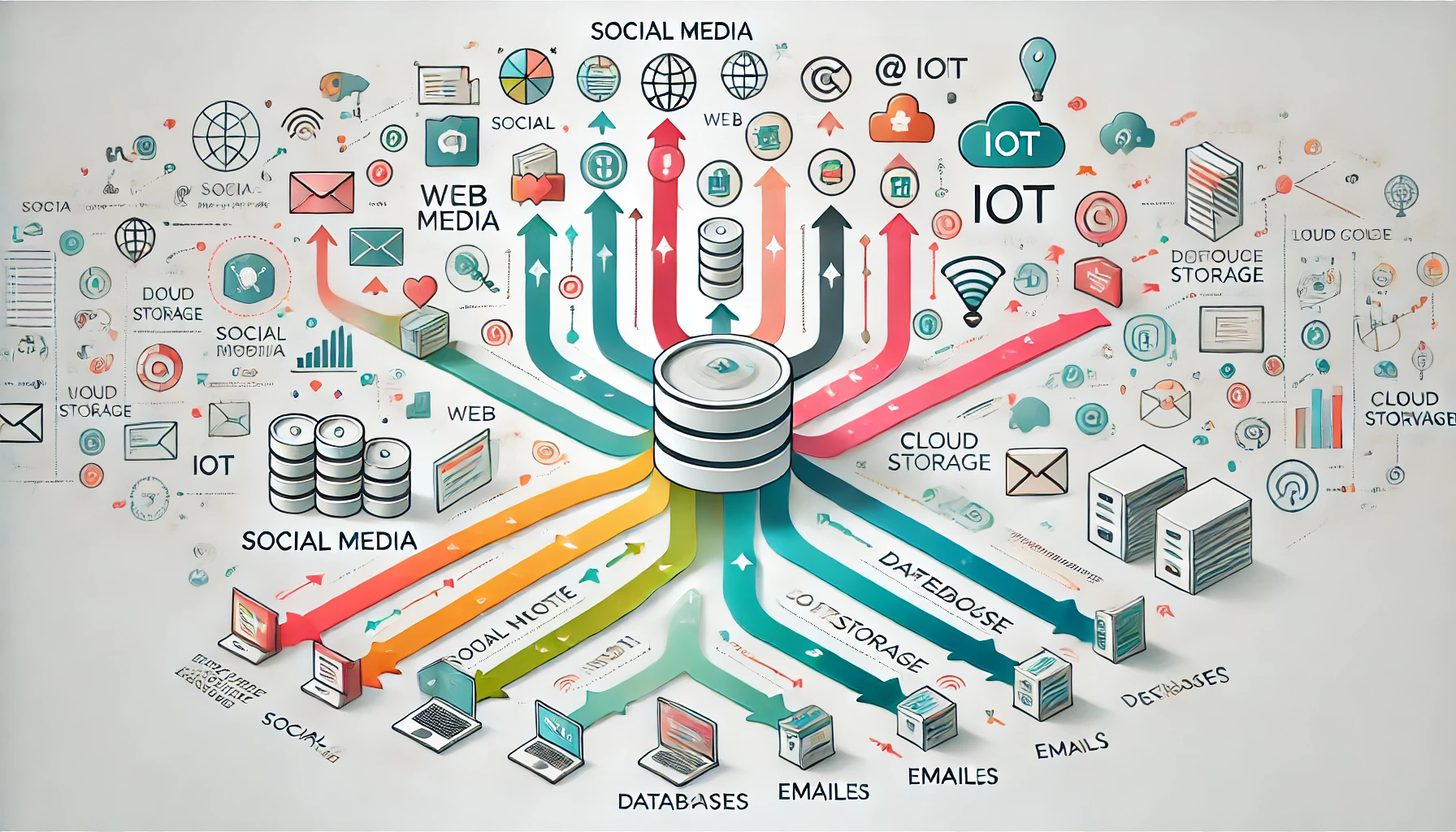
Harnessing Data in the Enterprise

In today’s data-driven world, enterprises rely on a variety of data sources to drive their decision-making processes. The complexity and diversity of these data sources can be overwhelming, but they provide a rich foundation for data analytics, data science, and the development of generative AI models. Let’s explore the types of data used in enterprise data platforms and how each can contribute to these fields.
Primary Data Sources
-
Surveys and Questionnaires
These tools collect direct responses from individuals, allowing businesses to gauge customer satisfaction, employee engagement, and market preferences. This data can feed into analytics models to identify trends and customer needs.
-
Interviews
Conducting one-on-one discussions yields in-depth insights into consumer behavior and employee experiences. Qualitative data from interviews enriches data science projects, providing context that quantitative data may miss.
-
Experiments
Controlled testing enables enterprises to gather data that reveals the effectiveness of new products or marketing strategies. The resulting data is crucial for A/B testing frameworks and predictive modeling.
-
Observations
By watching behaviors or events, organizations can collect raw data on user interactions and operational processes. This observational data can enhance machine learning models, especially in user experience (UX) design.
Secondary Data Sources
-
Academic Journals
These peer-reviewed articles offer reliable research findings that can validate assumptions or introduce new concepts. Data scientists often leverage this knowledge in developing theoretical models and frameworks.
-
Books
Comprehensive analyses from authoritative texts provide foundational knowledge in various fields, helping inform business strategies and technological implementations.
-
Reports
White papers and studies from reputable organizations can guide strategic decisions and highlight industry trends that affect an enterprise’s market positioning.
-
Government Databases
Statistical data from government sources, such as census data, is invaluable for demographic analysis and market research, ensuring businesses can make informed decisions based on population trends.
## Tertiary Data Sources
-
Encyclopedias
Summaries of knowledge across various fields provide quick reference points that can inform initial stages of research and data collection.
-
Databases
Compilations of data from multiple sources, such as bibliographic databases, enable cross-referencing and deeper insights into trends over time.
## Structured Data Sources
-
Databases
Relational databases (like SQL) house organized data, making it accessible for querying and analysis. Structured data forms the backbone of many analytics applications.
-
Spreadsheets
Widely used for data analysis, spreadsheets allow users to manipulate data in rows and columns, making them a practical tool for initial data exploration and reporting.
## Unstructured Data Sources
-
Text Data
Articles, social media posts, and blogs generate vast amounts of unstructured data that can be analyzed for sentiment, trends, and user opinions.
-
Multimedia
Images, audio, and video files provide rich content that can be analyzed using computer vision and audio processing techniques, crucial for generative AI models.
-
Emails and Communications
Internal correspondence can reveal insights about organizational culture and employee sentiment, useful for HR analytics.
## Open Data Sources
-
Public Datasets
Freely available data sets, such as open government data, provide a wealth of information for analysis, often used in academic research and public policy.
-
Community-Contributed Data
Platforms like Kaggle offer datasets shared by individuals and organizations, enabling collaboration and innovation in data science projects.
## Web Data Sources
-
Web Scraping
Extracting data from websites allows organizations to gather competitive intelligence, market trends, and customer reviews at scale.
-
APIs
Accessing data from online services and platforms via APIs enables real-time data integration and enriches existing datasets with dynamic information.
## IoT Data Sources
-
Sensors and Devices
Data generated from connected devices, such as smart home products and wearables, offers insights into user behavior and operational efficiency, feeding into predictive analytics.
## Transactional Data Sources
-
Sales Transactions
Data from sales records and e-commerce platforms is critical for understanding purchasing patterns, customer segmentation, and inventory management.
-
Financial Records
Banking and investment transaction data can drive financial analysis, risk assessment, and forecasting models.
## Geospatial Data Sources
-
GIS Data
Geographic Information Systems data supports mapping and spatial analysis, essential for urban planning and environmental studies.
-
Satellite Imagery
Data captured from satellites enables businesses to conduct analyses related to land use, climate change, and resource management.
Leveraging Data for Analytics, Data Science, and Generative AI Models
- Data Analytics
Data analytics involves examining raw data to uncover patterns, trends, and insights that inform business decisions. The diverse sources of data mentioned above provide a rich foundation for analytics:
Surveys can reveal customer satisfaction levels while transactional data helps identify sales trends. Combining structured databases with unstructured text data can provide a comprehensive view of customer sentiment through sentiment analysis techniques.
- Data Science
Data science encompasses a broader scope that includes statistical analysis, predictive modelling, machine learning, and more:
Experiments can serve as a basis for hypothesis testing in predictive models. Generative AI can utilize both structured datasets (like sales records) and unstructured datasets (like customer feedback) to create synthetic datasets that enhance model training without compromising sensitive information .
- Building Generative AI Models
Generative AI leverages existing datasets to create new content or simulate scenarios:
Using primary sources like surveys combined with secondary academic research can help train models that generate realistic customer interactions or product recommendations . By integrating IoT sensor data with historical sales transactions, businesses can build models that predict future demand based on environmental factors .
Conclusion
The variety of data sources available to enterprises creates a robust landscape for data analytics, data science, and the development of generative AI models. By effectively leveraging these diverse data types, businesses can extract actionable insights, drive innovation, and maintain a competitive edge in an ever-evolving market. Embracing a comprehensive data platform not only enhances decision-making but also paves the way for future advancements in technology and strategy.